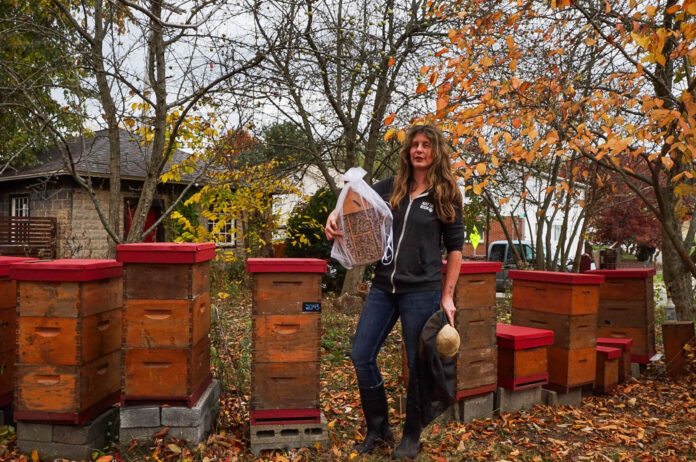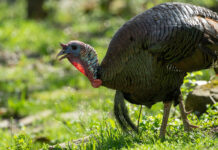
MILLVALE, Pa. — With only a bee veil for protection, CJ Newman meticulously sorts through her bee boxes, pulling out individual frames to inspect them. She’s checking to make sure everything is operating as normal in the hive before the cold weather rolls in.
Newman has been a sustainable beekeeper in Pittsburgh since 2005, and over time the honey products she makes have evolved. One of her newest products flies hand in hand with the region’s latest invasive species, an insect with spotted pink wings and the jumping abilities of a frog. It’s known as Lanternfly Honey.
To some, it may be weird, but to Newman, it’s just new.
“Beekeepers were describing it as horrible. I think they just meant it was unfamiliar,” Newman said. “I personally don’t like to use those words with honey because it’s not descriptive enough.”

The creation of Doom Bloom
In 2020, researchers at Penn State and beekeepers in Philadelphia started noticing an unusual-tasting honey in hives across the city.
Don Shump is the owner of Philadelphia Bee Co. which opened in 2012. His company makes different types of honey products and does bee removals around Philadephia. It was when he was doing a bee removal that he first noticed this strange honey.
“I walked in and looked at my guys and was like ‘Who’s eating maple bacon in here?’ because that’s what it smelled like,” Shump said. “(They said) it’s not us, it’s the honey. I gave it a taste and was like ‘I don’t know what this is.”
After discovering the unusual honey, Shump and other beekeepers across Philadelphia sent samples to Penn State to get it tested. Many of them were worried the honey could be a result of pesticides.
The honey ended up testing positive for lanternfly DNA and the chemical called ailanthone, which is found in the sap of the Tree of Heaven — one of the lanternflies’ favorite foods. Penn State had buckets of this now-deemed lanternfly honey and offered it to beekeepers, but most refused to take it back; they thought it was “too weird.”
Eager to see what it could be used for, Shump took a bucket and eventually brought it to a honey and cheese pairing. His cheese monger paired it with a Blue Cheese and it tasted great, “the hit of the night,” he says. Shortly after, he called Penn State and asked for the remaining buckets of lanternfly honey.
“I was like, ‘Give me all of that,’ please and thank you,” Shump said.
Shump started selling the product at Philadelphia’s 2020 Christmas Market, but it took off in March 2021. He marketed the product as Doom Bloom, its name stemming from a combination of world events in 2020 that felt like the world was ending.
“It was a collection of things that was going on. You had the pandemic, you had the lanternfly, the murder hornets were in the news, everybody was crazy about the politics,” Shump said. “Collectively everything was looking like the world was going to pot.”
Now Doom Bloom is one of Shump’s bestselling products. At the Christmas Market in 2021 and 2022, he had a line of people waiting to buy his lanternfly honey before the booth was even set up.
Newman’s lanternfly honey
CJ Newman, short for Christina Joy Newman, has been beekeeping in Pittsburgh since 2005. Looking to expand her knowledge of beekeeping, she moved to Hawaii in 2008 to work with Rare Hawaiian Honey. There she was able to receive in-depth training in the craft of sustainable beekeeping.
In early 2010, she moved back to Pittsburgh to pursue beekeeping on her own. Now, Newman’s company, Apoidea Apiary, has on average 80 hives within a six-mile stretch of downtown Pittsburgh.
Newman knew lanternflies were coming, but it wasn’t until 2021 that she noticed it in her colonies.
Tree of Heaven lines the industrial zones along the Pittsburgh rivers. The proximity resulted in a high concentration of lanternfly honey in Newman’s hives that are closer to the heart of downtown Pittsburgh.
Lanternflies excrete honeydew they can’t process on their food sources, like the Tree of Heaven, which the bees then pick up and bring back to the hive.
The first year Newman saw high enough concentrations to produce lanternfly honey was 2022. That year, she harvested 400 to 500 pounds of lanternfly honey.
“I was not freaking out like other beekeepers saying ‘What are we gonna do with this.’ I’m like, it’s interesting. I will figure something out,” Newman said.
She recently harvested honey for the 2023 season and doesn’t know how much of it contains lanternfly — but she has noticed lanternflies on more trees this year including mulberry, black walnut and silver maple trees.
Both Newman and Shump describe the taste of lanternfly honey as smokey. Newman equates the taste to Honey Baked Ham or bacon, noting it has salty undertones. Shump likes to pair the honey with charcuterie boards and put it on burgers.
Newman doesn’t have the lanternfly honey up for sale yet, but hopes to be selling it soon.
She will be opening up a cafe gallery for her business, called CoNectar, in Millvale in February 2024. She anticipates selling her various honey products there, including lanternfly honey, as well as hosting informational sessions about beekeeping and how bees work to maintain a sustainable environment.
For now, though, Newman continues to harvest honey and is interested to see how lanternflies will evolve in the region.
“It’s horrifying and super interesting, watching the whole invasive situation unfold and trying to understand the ecological dynamics. Some are positive, some are negative. The honeydew is arguably something kinda beneficial, but we don’t know the damage that they’re causing these trees in the longer run,” Newman said. “It’s like you’re trying to see how things are gonna balance.”
Despite some unpopular opinions and the controversy surrounding lanternflies, Shump says the creation of lanternfly honey is about taking the positive out of the negative. He notes this isn’t the first time the state has seen an invasive species made into honey — referring to Japanese Knotweed which also came from Asia.
“The way I put it is that we’ve making good out of a bad thing,” Shump said. “There’s no eradicating it, there’s no getting rid of it. We’re not promoting their growth, but if they’re here, we’ll certainly take advantage of them.”
For more information on CoNectar and the Philadelphia Bee Co., visit https://www.co-nectar.com/ and https://www.philadelphiabee.com/.
(Reporter Liz Partsch can be reached at epartsch@farmanddairy.com or 330-337-3419.)





















